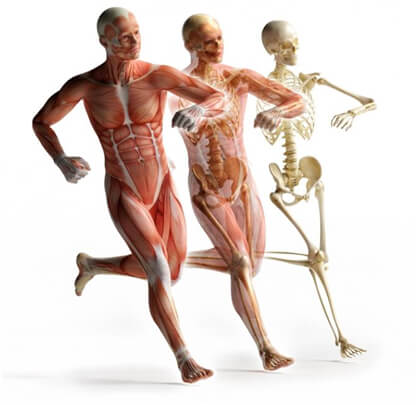
Why is Myofascial Release Important for Good Health?
Fascia – the new buzzword in the exercise and medical industry. But what exactly is it, and should we all be paying more attention to this often overlooked aspect of our anatomy?
So, What Exactly is Fascia?
Fascia a clingfilm-like, elastic substance that wraps around all our muscles and organs, offering support and reducing friction during everyday movement.
It is the connective tissue that is woven around each and every muscle, bone, nerve, artery and vein in our bodies, as well as all of our internal organs, including the heart, lungs, brain and spinal cord. It is quite literally what holds us together. Evidence suggests that the fascia can be damaged by both physical and mental impact.
In structure, fascia is like candy floss or a knitted sweater; tightly interwoven and web-like. If you picture an orange, it is similar to the transparent layer of skin that surrounds each and every segment. It is thin white layer beneath the skin, similar to what you see when you cut up a chicken breast.

Myofascial Pain Syndrome
Myofascial Pain Syndrome (MPS) is just another term for muscle pain. It refers to pain, inflammation and soft tissue manipulation in the body.
MPS is a chronic condition that affects the fascia involving either a single muscle or multiple muscle groups. The area where one experiences pain may not be where the myofascial pain generates from. There is usually a trigger point that causes the pain to be distributed to other areas.
What Causes Myofascial Pain?
It develops from a muscle injury or from excessive strain on a muscle, muscle groups, ligament or tendon. Other causes include:
- Injury to muscle fibers
- Repetitive motions
- Lack of more physical activity
How Is Myofascial Pain Diagnosed?
The diagnosis of myofascial pain is done by a doctor or physiotherapist in Singapore. They mainly look at areas of pain and where it is stiff and adding stress to the place that hurts. It can be diagnosed from trigger points that can be identified by pain that results when pressure is applied to a specific area of the body. They can be categorized as:
- An active trigger point – this is the area of extreme sensitivity that exists within the skeletal muscle and is identified by a local or regional pain.
- A latent trigger point – this is a dormant (inactive) area that has the potential to act like a trigger point. It may cause muscle weakness or restriction of movement.
How Is Myofascial Pain Treated?
Myofascial pain is not life-threatening but it can significantly affect quality of life. Myofascial Release is a set of techniques that aim to give fascia a movement, stretching and gliding it so your body works at its optimum level. In recent years, doing exercises with foam rollers, massage balls, and the like has gained immense popularity. New products claiming to provide self-myofascial release are constantly being introduced into the market, but knowing what to do and how to do it can be an intimidating task. At worst, doing exercises wrong can lead to pain and discomfort, and ultimately injury.

Myofascial release, if done by a trained professional, can reach out to many systems of the body including the fascia itself, muscles, ligaments, nerves, skin and blood vessels. Benefits include:
- Muscle Relaxation
It helps in the reduction and elimination of stored tension in the muscles which helps in escaping pain and aches. It activates sensory receptors connecting the muscle fibers to the tendons. - Reduces Soreness and Joint Stress
It boosts recovery because of better blood circulation allowing more oxygen and nutrients to reach the muscles and soft tissues. - Improve Joint Range Motion
It helps prepare joints for increased range of motion by breaking the knots in the muscles. - Corrects Muscle Imbalance
It helps the muscle relax and also provide optimal length-tension to avoid muscle restrictions when one performs an exercise.
